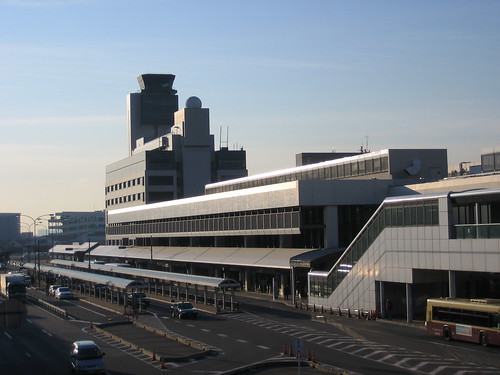The media is reporting that Osaka governor Toru Hashimoto is thinking of demolishing Itami Airport and building an international academic village on the property where everybody speaks English. People are already raising hell about this idea over at Debito’s blog. I think it’s a silly idea (as presented, anyway) and will never make it out of committee, but the issue of what to do with Itami is still pertinent, as Osaka really doesn’t need three airports.
What can you do with an airport you don’t need any more? Here are five possibly pertinent examples:
- Kai Tak Airport, Hong Kong
Kai Tak has many parallels to Itami. It was mostly built by the Japanese military (during their wartime occupation of Hong Kong), and it occupied a prime central location in huge city that grew increasingly dense over the years. As a result of the latter, the airport was cramped, overcrowded and hair-raisingly difficult to get into: aircraft landing in one direction had to approach the runway at a right angle, then make a hairpin turn just above the ground to touch down (video). Kai Tak was replaced by a somewhat Kansai-like airport, the current Hong Kong International Airport, in 1998, and was promptly closed. Since then, the site has been more or less empty despite constantly-shifting plans to build hotels, cruise piers and a giant stadium there.
- Stapleton Airport, Denver
In its heyday, Stapleton was one of the busiest airports in the world, serving as a cross-country hub for Continental Airlines and United Airlines. Like Itami, though, it was in the middle of a mostly residential area, which limited its growth potential and caused friction with residents over noise. In the early 90s, the federal government threw millions of dollars into an enormous new airport on the outskirts of the city, Denver International Airport, which is now the second-largest airport in the world. Stapleton was then closed down, and the site converted into a “new town” of 30,000 people.
(Aside: I visited Denver last November, and the airport strikes me as totally ridiculous–you pass the sign that says “WELCOME TO DIA,” and the next sign says “TERMINALS – 15 MILES.” The largest airport in the world is in Dammam, Saudi Arabia and is larger than the entire country of Bahrain.)
- Hoover Field, Washington
Hoover Field was the first airport in the capital of the United States, back in the earliest days of commercial aviation. It was built across the river from the city in Arlington, Virginia on the other side of the 14th Street Bridge. The site was incredibly cramped, though–most notably, there was a road running through the middle of the main runway, requiring railway crossing gates to be lowered whenever a plane took off or landed. The field was shut down around the start of World War II, when National Airport opened nearby, and the site was then used to build the Pentagon.
- Meigs Field, Chicago
Meigs was a small airport on an artificial peninsula right on the lakefront of Chicago–essentially a miniature 1930’s version of Kansai Airport. It was most famous in its heyday for being the default starting location in Microsoft Flight Simulator. Mayor Richard Daley started campaigning in the early 90’s to convert the site into a giant park, and after a decade of bureaucratic stalling by Congress and the FAA, he took matters in his own hands and ordered the runway bulldozed into uselessness overnight. The site is now a lakefront park and was briefly being sold as a potential venue for the 2016 Olympics.
- Old Kitakyushu Airport, Kitakyushu
This is probably the closest parallel in Japan to a potential Itami closing scenario. The old Kitakyushu Airport was a relatively small facility, with one runway and a handful of daily flights to Haneda Airport in Tokyo, using relatively small YS-11 prop planes, later replaced by faster but still small MD-80 jets. The airport was clearly a bit of joke even in the mid-70s, and so the local government commissioned a new, larger offshore airport nearby, which opened in 2006 (and, surprisingly enough, is still not all that popular). The site was initially envisioned as a new urban project, but there were no takers; economics finally came out victorious, and the site is now zoned for industrial use, housing a hospital and a couple of industrial production sites.
There is one fate which Osaka undoubtedly wants to avoid–the fate of Montreal. Montreal spent something like a billion dollars to build and expand a giant airport on the outskirts, Mirabel Airport, which would have been the largest in the world were it ever completed. Just like Osaka, Montreal projected that their old downtown airport, Dorval, would quickly become too small for demand, and they tried to lock international carriers into the more distant Mirabel in order to artificially boost its popularity despite stagnating overall demand. The result was that Montreal lost relevance as an air hub, since nobody wanted to connect between the airports, and the city was getting less internationally relevant anyway. Montreal eventually gave up on Mirabel and moved everything back to Dorval in the nineties, leaving their gleaming new airport as a gleaming white elephant plied only by a few cargo planes.
So what could Osaka do with Itami Airport’s site? As a former Itami resident (I had a host family there back during my first stay in Japan), I have some ideas of my own.
First of all, it would be great as a replacement for the rail freight yard in Umeda, which is a pretty wasteful use of downtown space. ITM is right next to a JR trunk line and could be connected fairly easily — it also isn’t far from the Sanyo Shinkansen, which could theoretically be used for some freight traffic in the future once everything goes maglev. Then the downtown space occupied by the current yard could be fully converted into residential or commercial buildings. (UR has actually already started this process on one side of the yard.) This would also fit in fairly well with the light industrial character of the immediately surrounding real estate.
If you want to get a bit more fantastic, how about a space elevator? Or perhaps a new central government location for some of those Tokyo-bound bureaucrats? (I already proposed a similar fate for KIX in comments to this post.) Perhaps the Defense Ministry could move out there and give up its nice space in Ichigaya, though I’m sure the more lefty locals wouldn’t like that plan.





